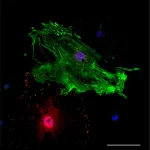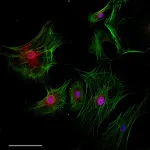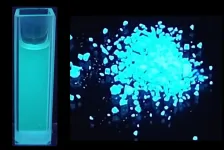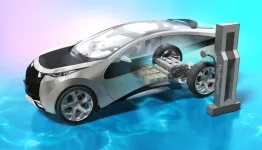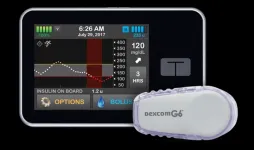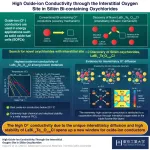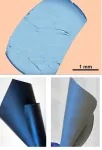(Press-News.org) A recent study using mice has revealed a way to turn back the clock after heart attack. The researchers behind the work used RNAs to instruct cells in an injured heart to eliminate scar tissue and recreate cardiac muscle, allowing the heart to function like new again.
Cardiovascular disease, including heart attack, is the leading cause of death worldwide.
“Adult human hearts are not very good at repairing themselves,” said Conrad Hodgkinson, an associate professor of medicine and pathology at Duke University School of Medicine who oversaw the study. “Once they have a heart attack or any type of damage, there's no capacity to replace the heart muscle that dies. So, what the heart does to stop itself from basically blowing up is it activates fibroblasts to come in and form a scar.”
Like the scars on skin that result from injury or surgery, the scar tissue generated in the heart after a heart attack is tough and nonflexible and can prevent the organ from functioning at its full potential, Hodgkinson said.
Hodgkinson and his team wanted to find an efficient way to convert the scar tissue back into functioning cardiac muscle to essentially reverse the effects of a heart attack. To do this, they set out to find a way to transform fibroblasts, a type of cell that contributes to the formation of connective tissue, into heart muscle cells via a process called cellular reprogramming. Hodgkinson’s lab delivers reprogramming instructions to cells in form of RNAs. However, they found adult fibroblasts are not very good at following the instructions and are resistant to reprogramming.
An old adage states: Kids are resilient. However, there may be biology to back it up.
“We found that if you take cardiac fibroblasts from juveniles, they reprogram very nicely,” Hodgkinson said. “But, if you take cardiac fibroblasts from adults, they don't, in fact, respond at all. So, we tried to understand whether the aging process was actually interfering with fibroblast reprogramming.”
Hodgkinson and his team discovered that a protein oxygen sensor, Epas1, prevents adult fibroblasts from reprogramming themselves. The researchers were able to harness the regenerative capacity of young cells by blocking Epas1 in adult fibroblasts.
“When we reversed the fibroblast aging process, essentially making the fibroblasts think they were young again, we converted more fibroblasts into cardiac muscle,” Hodgkinson said.
The researchers formulated a cocktail of RNAs and packaged them into exosomes, a natural product produced by most cells. This technology allowed them to deliver the exosomes without surgical interventions. Exosome packages have unique properties that guide them to cardiac fibroblasts inside an injured heart.
“Exosomes are kind of like shopping bags,” Hodgkinson said. “The cell sticks a lot of stuff into a big fat ball to send out and signal to other cells. They are a way cells can talk to each other.”
When the researchers used the RNA-filled exosomes to instruct the fibroblasts to reprogram themselves in a mouse that had just experienced a heart attack, the results were, according to Hodgkinson, “impressive.”
“We were able to recover almost all of the cardiac function that was lost after a heart attack by reversing the aging of the fibroblasts in the heart,” Hodgkinson said. Their findings were published in the Journal of Biological Chemistry.
Cellular reprogramming, coupled with reversing cellular aging, has limitless future applications, including restoring neuron loss in the brains of dementia patients and eliminating skin scarring in psoriasis patients without invasive surgical interventions, Hodgkinson said.
About the American Society for Biochemistry and Molecular Biology (ASBMB) The ASBMB is a nonprofit scientific and educational organization with more than 12,000 members worldwide. Founded in 1906 to advance the science of biochemistry and molecular biology, the society publishes three peer-reviewed journals, advocates for funding of basic research and education, supports science education at all levels, and promotes the diversity of individuals entering the scientific workforce. For more information about the ASBMB, visit www.asbmb.org.
END
A second chance for a healthy heart
Researchers use cellular reprogramming to make damaged organ almost good as new
2023-04-19
ELSE PRESS RELEASES FROM THIS DATE:
Study explores prosocial behavior within, between religious groups
2023-04-19
Does a commitment to one’s God facilitate altruistic behavior that benefits only members of the same religious group? Or does it extend to helping members of a different religion?
University of Illinois Chicago social psychologist Michael Pasek and colleagues examined this question through field and online experiments involving more than 4,700 people from diverse ethnoreligious populations in three political and cultural contexts.
Christians, Muslims, Hindus and Jews in the Middle East, Fiji and the United ...
Bad medical news causes patients to choose brand name drugs over generics, costing billions
2023-04-19
Researchers from Johns Hopkins University published a new Journal of Marketing article that examines how receiving negative medical results might affect how people choose between generic and brand name drugs.
The study, forthcoming in the Journal of Marketing, is titled “Does Bad Medical News Reduce Preferences for Generic Drugs?” and is authored by Manuel Hermosilla and Andrew T. Ching.
At the height of the COVID-19 pandemic, Manuel Hermosilla received a call from a family friend in Chile who had been recently diagnosed with cancer. The friend needed help tracking down Hydroxychloroquine to treat ...
Healthy ageing and longevity: topic for scientific meeting on Okinawa
2023-04-19
The Japanese island Okinawa is known for its high number of centenarians, healthy diet and lifestyle. Due to this it is one of the few areas in the world that is called “blue zone”. During May 12-13, leading international scientists and inspiring speakers will meet on Okinawa for two full days of talks about the latest research on longevity and healthy ageing – and what we can learn from so called “blue zones”.
“It is a perfect place to interact, update and develop the research ...
Fluorescent blue coumarins in a folk-medicine plant could help us see inside cells
2023-04-19
Plants that glow under ultraviolet (UV) light aren’t only a figment of science fiction TV and movies. Roots of a traditional medicine plant called the orange climber, or Toddalia asiatica, can fluoresce an ethereal blue hue. And now, researchers in ACS Central Science have identified two coumarin molecules that could be responsible. These natural coumarins have unique fluorescent properties, and one of the compounds could someday be used for medical imaging.
Fluorescent substances take in UV light that’s directed ...
Nagoya University researchers in Japan develop a new ultra-high-density sulfonic acid polymer electrolyte membrane for fuel cells
2023-04-19
In a project commissioned by the New Energy and Industrial Technology Development Organization (NEDO), researchers at Nagoya University in Japan have developed poly(styrenesulfonic acid)-based PEMs with a high density of sulfonic acid groups.
One of the key components of environmentally friendly polymer electrolyte fuel cells is a polymer electrolyte membrane (PEM). It generates electrical energy through a reaction between hydrogen and oxygen gases. Examples of practical fuel cells include fuel cell vehicles (FCVs) and fuel cell combined heat and power (CHP) systems.
The best-known PEM is a membrane based on a ...
UVA-developed artificial pancreas benefits both kids and adults with diabetes, new analysis finds
2023-04-19
An artificial pancreas developed at the University of Virginia Center for Diabetes Technology improves blood sugar control for people ages 2 to 72 with type 1 diabetes, according to a new combined analysis of three clinical trials.
Across the three trials, participants using the artificial pancreas spent an average of 2.8 more hours per dayin their target blood sugar range compared with participants in control groups who used standard methods for managing their blood sugar.
Manufactured by Tandem Diabetes Care and sold as the Control-IQ system, the artificial pancreas is ...
Novel oxychloride shows high stability and oxide-ion conduction through interstitial oxygen site
2023-04-19
Solid oxide fuel cells (SOFCs) are a promising solution to the contemporary problem of the impending global energy crisis. SOFCs show high efficiency, lower emissions, and have low operating costs, making them an ideal power source for a fossil fuel-free society.
Conventional SOFCs with yttria-stabilized zirconia (YSZ) electrolytes have high operating temperatures (700–1000°C), and their widespread adoption has been limited by their degradation issues and high cost. Therefore, there is a need ...
UCR team creates “quantum composites” for various electrical and optical innovations
2023-04-19
A team of UCR electrical engineers and material scientists demonstrated a research breakthrough that may result in wide-ranging advancements in electrical, optical, and computer technologies.
The Marlan and Rosemary Bourns College of Engineering research group, led by distinguished professor Alexander Balandin, has shown in the laboratory the unique and practical function of newly created materials, which they called quantum composites.
These composites consist of small crystals of called “charge density wave quantum materials” incorporated within a polymer (large molecules with repeating structures) matrix. Upon heating or light exposure, charge density wave material ...
Black and socioeconomically disadvantaged patients with vascular disease have worse symptoms, bypass outcomes
2023-04-19
A Michigan Medicine study finds that Black and socioeconomically disadvantaged patients with a common vascular disease have more severe symptoms before bypass surgery – and are at greater risk for amputation and other complications after the procedure.
The analysis zeroed in on more than 7,000 patients with peripheral arterial disease, when the vessels carrying blood from the heart to the legs are blocked by plaque, who underwent lower extremity bypass to improve circulation. The data was available through the Blue Cross Blue Shield of Michigan Cardiovascular Consortium database.
Investigators found ...
Prenatal depression may be linked to cardiovascular disease after childbirth
2023-04-19
Research Highlights:
A study of more than 100,000 people in the U.S. has found an association between individuals’ psychological well-being during pregnancy and their risk of developing cardiovascular disease within two years of delivery.
The most significant association was between depression and ischemic heart disease, with individuals with depression having an 83% higher risk of developing the condition than those without a depression diagnosis.
The increased risk of cardiovascular disease was found even among individuals without high blood pressure ...
LAST 30 PRESS RELEASES:
Injectable breast ‘implant’ offers alternative to traditional surgeries
Neuroscientists devise formulas to measure multilingualism
New prostate cancer trial seeks to reduce toxicity without sacrificing efficacy
Geometry shapes life
A CRISPR screen reveals many previously unrecognized genes required for brain development and a new neurodevelopmental disorder
Hot flush treatment has anti-breast cancer activity, study finds
Securing AI systems against growing cybersecurity threats
Longest observation of an active solar region
Why nail-biting, procrastination and other self-sabotaging behaviors are rooted in survival instincts
Regional variations in mechanical properties of porcine leptomeninges
Artificial empathy in therapy and healthcare: advancements in interpersonal interaction technologies
Why some brains switch gears more efficiently than others
UVA’s Jundong Li wins ICDM’S 2025 Tao Li Award for data mining, machine learning
UVA’s low-power, high-performance computer power player Mircea Stan earns National Academy of Inventors fellowship
Not playing by the rules: USU researcher explores filamentous algae dynamics in rivers
Do our body clocks influence our risk of dementia?
Anthropologists offer new evidence of bipedalism in long-debated fossil discovery
Safer receipt paper from wood
Dosage-sensitive genes suggest no whole-genome duplications in ancestral angiosperm
First ancient human herpesvirus genomes document their deep history with humans
Why Some Bacteria Survive Antibiotics and How to Stop Them - New study reveals that bacteria can survive antibiotic treatment through two fundamentally different “shutdown modes”
UCLA study links scar healing to dangerous placenta condition
CHANGE-seq-BE finds off-target changes in the genome from base editors
The Journal of Nuclear Medicine Ahead-of-Print Tip Sheet: January 2, 2026
Delayed or absent first dose of measles, mumps, and rubella vaccination
Trends in US preterm birth rates by household income and race and ethnicity
Study identifies potential biomarker linked to progression and brain inflammation in multiple sclerosis
Many mothers in Norway do not show up for postnatal check-ups
Researchers want to find out why quick clay is so unstable
Superradiant spins show teamwork at the quantum scale
[Press-News.org] A second chance for a healthy heartResearchers use cellular reprogramming to make damaged organ almost good as new
